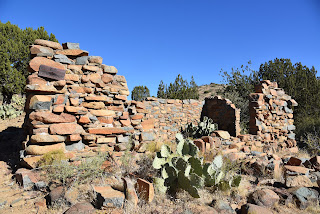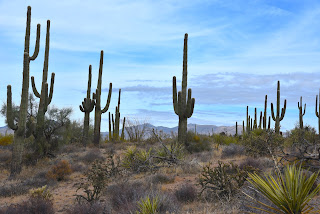Black Canyon Trail to Russian Well
 |
| The working windmill at the Russian Well site |
The Black Canyon National Recreation Trail is quietly expanding its northern reach.
Efforts to extend the 80+-mile historic route that stretches from Phoenix to the outskirts of Prescott are taking shape in the Verde Ranger District of Prescott National Forest.
 |
| Black Canyon Trail is expanding in the Prescott National Forest |
While there are already numerous easy-access trailheads scattered along the route, plans for better connectivity and loop options in the Verde Valley are in progress.
 |
| Scenic spot at the hike's high point |
One off-the-beaten- path trailhead that’s currently open and flagged for enhancement is the Russian Well segment northeast of the town of Mayer. Situated in stunning back country of rolling hills, washes and scrubby rangeland, this remote stretch of trail, which (as of this writing) follows a signed temporary alignment on dirt roads is also packed with relics of the area’s past.
 |
| Rustic stone structure at Russian Well |
It’s a starkly beautiful, curious place with multiple personalities. The hike starts out with a walk among low-growing pockets of mesquite, scrub oak, cacti, yucca and thickets of cat claw shrubs that punctuate largely barren grasslands. The undulating path dips and climbs through wide open spaces where domestic cattle graze and deer might be sighted darting among scant stands of juniper trees. At the top of the first rise, the cottonwood-lined course of Yarber Wash in a depression below cuts a ribbon of color among the muted tones of the surrounding chaparral.
 |
| Black Canyon Trail traverses mineral-rich back country |
The road twists downhill and crosses the sandy riparian strip before heading uphill again to a cattle guard and fence line signed for U Cross Ranch.
 |
| Russian Well site and Copper Mountain (center horizon) seen from the trail |
Another mild uphill section lands at a corral where some of the most sweeping vistas of the hike come into view. Look for the long profile of the Bradshaw Mountains in the west, Pine Mountain Wilderness to the east and the prominent peak of Copper Mountain to the southwest. Strewn with salt licks (blocks of minerals placed for resident cattle) and strung with barbed wire, the high corral site marks the beginning of the history segment of the hike.
 |
| The trail crosses tree-lined Yarber Wash |
 |
| Artifacts at the abandoned Tri-Metal Mine site |
 |
| A water trough at Russian Well attracts wildlife |
From here the road approaches the boundary of Prescott National Forest and enters Bureau of Land Management territory and dips downhill along a rough road cut that exposes some of the complex geology that attracted prospectors to mineral-rich volcanic deposits. At the 2.9-mile point, the trail encounters an intersection above the tiny oasis of the Russian Well outpost.
 |
| U Cross Ranch site on the Black Canyon Trail |
The left fork heads up to the Tri-Metals Mine while the right spur continues downhill on the Black Canyon Trail to the well. The Russian Well locale makes for interesting exploring. Ringed by massive, clearly ancient junipers, the site straddles Brushy Wash, a deeply incised drainage where a working windmill pumps groundwater into a collection of tanks and an open-air water trough. A picturesque, partially collapsed stone building surrounded by splintered timbers and metal scraps stands above a small corral at the edge of the wash.
 |
| The corral at Russian Well |
 |
| Juniper trees surround the Russian Well corral |
A walk around the place reveals signs of active wildlife, including raucous, steel-blue pinion jays that flit around the water trough, and scatterings of rusted cans and odds-and-ends that reveal little about the well’s original builders except maybe they ate beans and drank beer. As with all heritage sites, leave everything as you found it.
 |
| Prescott National Forest mountain views abound on this hike |
Russian Well is the turnaround point for this hike, however, the trail continues south on the route’s Copper Mountain segment.
 |
| Ruins of the Tri-Metal Mine prospect |
It’s 10.2 miles to the next substantial access point—the Big Bug trailhead off State Route 69 near the town of Mayer. For an out-an-back hike, there’s more to explore on the return trip. Hike back up to the road junction and follow the opposite fork to the mine.
 |
| Scrubby rangeland dominates the hike |
During its operating life, the defunct Yavapai County prospect yielded silver, gold, copper and lead. Two filled-in digs, waste piles and a group of disintegrating concrete foundations and structures are all that remain. You’d be hard pressed to find any remnants riches lying about, but a display of oxidized detritus like nuts, bolts and unidentifiable parts scattered among the ruins are more mundane treasures to observe in place while gazing out over layers of foothills and mountain peaks.
LENGTH: 7.1-mile round trip as described here
RATING: moderate
ELEVATION: 4,189 – 4,517 feet
GETTING THERE:
From Phoenix go north on Interstate 17 to the Orme/Dugas Road exit 268 north of Cordes Junction. Turn left at the bottom of the offramp and follow Orme Road (County Road 169) 7.1 miles to the trailhead on the left. There’s a Black Canyon Trail sign at the entrance to a large dirt lot. Hike begins at the trail post at the south side of the lot
Roads are maintained dirt suitable for all vehicles.
INFO: Black Canyon Trail Coalition







































